automotive design
Small Overlap Crash Test

The influx of all the amazing new electronic safety aids and crash avoidance systems found on-board new cars has been exceptional. There is no doubt that these systems are helping save lives and minimising injury. There has been one part of the latest car crash testing regime that the Insurance Institute for Highway Safety (IIHS) has brought in as part of their testing in order to help make cars safer.
The IIHS is an independent, non-profit scientific and educational organization dedicated to reducing deaths, injuries and property damage from motor vehicle crashes through their ongoing research and evaluation, and through the education of consumers, policymakers and safety professionals. The IIHS is funded by auto insurance companies and was established back in 1959. Its headquarters is in Arlington, Virginia, USA. A lot of what the IIHS does is crash test cars in a variety of ways to gather data, analyse the data, and observe the vehicles during and after the crash tests to quantify how safe each car is. The results and findings are published on their website at IIHS.org. Car manufacturers have been forced to take these tests seriously because, at the end of the day, these results matter and will affect car sales as the public become informed about how safe their cars will likely be in the event of an accident.
Since 2012, the IIHS has introduced a couple of new tests that they put the vehicles through to see how safe they are in an event of small overlap collision. The driver-side small overlap frontal test was brought about to help encourage further improvements in vehicle frontal crash protection. Keeping in mind that these IIHS tests are carried out using cars with left-hand-drive, the test is designed to replicate what happens when the front left corner of a vehicle collides with another vehicle or an object like a tree or utility pole. This crash test is a challenge for some safety belt and airbag designs because occupants move both forward and toward the side of the vehicle from the time of impact. In the driver-side small overlap frontal test, a vehicle travels at 40 mph (64 km/h) toward a 5-foot-tall rigid barrier. A Hybrid III dummy representing an average-size man is positioned in the driver seat. 25% percent of the total width of the vehicle strikes the barrier on the driver side.
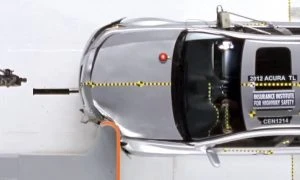
Most modern cars have safety cages encapsulating the occupant compartment and are built to withstand head-on collisions and moderate overlap frontal crashes with little deformation. At the same time, crush zones help manage crash energy to reduce forces on the occupant compartment. The main crush-zone structures are concentrated in the middle 50% of the front end. When a crash involves these structures, the occupant compartment is protected from intrusion, and front airbags and safety belts can effectively restrain and protect occupants.
However, the small overlap frontal crashes primarily affect a vehicle’s outer edges, which aren’t well protected by the crush-zone structures. Crash forces go directly into the front wheel, the suspension system and the firewall. It is not uncommon for the wheel to be forced rearward into the footwell, contributing to even more intrusion into the occupant compartment, which often results in serious leg and foot injuries. To provide effective protection in these small overlap crashes, the safety cage needs to resist crash forces that haven’t been amplified, concentrated on one area or aren’t tempered by crush-zone structures. Widening these front-end crash protection structures does help.
The IIHS also performs the passenger-side small overlap frontal test. The passenger-side test is the same as the driver-side test, except the vehicle overlaps the barrier on the right side. In addition, instead of just one Hybrid III dummy, there are two — one in the driver seat and one in the passenger seat.

Automotive manufacturers initially responded to these driver-side small overlap test results by improving vehicle structures and airbags, and most vehicles now earn good ratings. However, IIHS research tests demonstrated that those improvements didn’t always carry over to the passenger side. Discrepancies between the left and right sides of vehicles spurred the IIHS to develop a passenger-side small overlap test and begin issuing passenger-side ratings in 2017.
It is good that vehicle safety always seems to be on the improve and, with each new model, the new-car buyer can expect a safer vehicle. Thanks to crash testers like the IIHS, ANCAP and Euro NCAP, we are experiencing safer cars on our roads.
Materials used for Seating in Modern Cars

If you’re looking to by a new car, one of the most important things to consider, aside from practicality, safety, and exterior looks, is its interior. The interior is important because this is going to be where you spend most of your time with your new car. You are going to want it to look great and feel comfortable, so, obviously, the seats are massively important. Here are the types of seating materials and a bit of info on each type so that you may be better informed when it’s time for your new upgrade.
Nylon Car Seats
If the car has fabric seats, then it is more than likely going to be nylon or polyester material. Nylon is one of the most common car seat materials that car upholsterers use, and you’ll often find it trimming the base and lower trims of the particular model of car that you are looking to buy. Nylon has very good durability and is also resistant to heat. Because of its stretchability, the seats can also be quite comfortable to sit in, but essentially the comfort comes down to how the car manufacturer has designed the seat’s internals. Nylon materials aren’t that expensive to produce, so car manufacturers like to use this lower cost material. A good vacuum cleaner with a soft-bristled brush easily tidies them up and, if a spill occurs, the nylon can be cleaned relatively easily with warm soapy water or a decent upholstery shampoo. Nylon is porous, so what gets spilled on the seats can work into the cushion structure.
Vinyl Car Seats
Vinyl is also commonly used in car seat upholstery and it is also quite affordable to use in car manufacturing. Vinyl is very easy to clean and maintain and it also mimics leather in its looks. Vinyl is not very porous either, so dirt and dust doesn’t easily make its way into the seat’s internals. You can usually just wipe the vinyl upholstery with a damp cloth in order to clean it effectively. It also vacuums easily. Vinyl will get hot in the summer, so darker colours will absorb the heat and transfer the heat very quickly onto your bum – you have been warned!
Leather Seats
Leather upholstery is what you will find in premium models. It is an expensive material to use and looks amazing. Leather is a porous material and also stays cooler in the summer than its cheaper vinyl cousin. One of the drawbacks of leather upholstery is it does require the correct cleaning and maintenance products. If the wrong products are used, then the leather will fade and harden. Salt and leather don’t go well together – often a forgotten fact as people jump back onto the leather seats in wet togs after a swim at the beach. Leather is a tough material and therefore durable, however when it does get damaged (e.g., damage caused by sharp objects or salt) it can be difficult to fix.
Faux Leather Car Seats
Faux leather or artificial leather is a commonly used material in modern vehicles. It looks classy but is less expensive than the real thing. Faux leather is also easy to clean and waterproof but doesn’t breathe like standard leather and can also get hot in the summer!
Alcantara Car Seats
Alcantara is a suede-like car seat material that is made from 68% polyester and 32% polyurethane. Alcantara is a premium material, very durable and looks amazing. It is also expensive, gets dirty relatively quickly, and can fade quickly.
Polyester Car Seats
Polyester is a material called microsuede, and it looks and feels similar to normal suede. It is also similar to Alcantara. Polyester is a cheaper alternative to Alcantara and is comfortable. It isn’t considered quite as premium as Alcantara because it is not that easy to clean, and it is a fabric prone to picking up the dirt quite easily. You have to gently use a soft fabric cleaner with a damp cloth to clean the seats otherwise it can damage. Water and other liquids also stain the fabric quite easily.
Will we see new types of cars after COVID?
There is sufficient reason to believe that cars of the future may well incorporate new design principles in the wake of COVID-19.
At least, that’s the view according to various car manufacturers, who have begun to envisage a different future for the automobile after the disruption caused by the pandemic, as well as the impact on supply chains that are so critical for vehicle production.
What changes are being touted?
Vehicle design could be in for a significant overhaul it would seem…albeit perhaps not just yet. Nonetheless, what will be a key driver, at least based on early discussions with car designers thus far, is how the mindset of drivers will influence tomorrow’s generation of new cars. And amid the changes of the last year, there can be no denying that the mindset of the modern driver now has other needs that would have seemed inconsequential 12 months ago.
More specifically, however, things like anti-viral coatings could become standard on interior surfaces. This is an area that both Kia and Hyundai have identified as a potential need in the future as they work on “virus-proof” cabins through the use of self-sterilising materials. What’s more, there is even some talk that the way to achieve this could be through the possibility of using temperature and ultraviolet light to sanitise surfaces.

Will the format of the car change as we know it?
At first there was also some train of thought that social distancing behaviour could also give rise to a new breed of vehicles, which would be short-range micro electric vehicles. These would effectively act as a supplement to other forms of transit such as public transport, bicycles and walking. Rather than an all-in-one motoring solution that many brands have tried to embrace through SUVs, and more recently, crossovers, this type of vehicle would be designed more simply as functional units, without the necessary frills that we’ve come to expect in all of the latest-release cars.
However, the trend of new car buying throughout the pandemic has almost universally opposed this notion. In fact, buyers continue to flock to bigger and bigger cars, perhaps spurred on by the fact that they now want to travel longer distances and in more diverse environments. Naturally, it’s no surprise then that SUVs and dual-cab utes are dominating the market with their 4×4 capabilities, let alone spacious cabins and large cargo holds.
There is no denying that recent trends up until COVID-19 were all about shared mobility and peer-to-peer service. With that turned on its head in recent time as we stay at home and keep our distance from others, there is also likely to be some attention shift towards how the internal cabin connects all of the vehicle’s occupants. It is distinctly likely that cars will need to prioritise a more deliberate design when it comes to shared mobility, at least for the purposes of helping us uphold the momentum as far as the shared mobility trend.
Now a full year on from the onset of the pandemic, new observations keep leading to new possibilities. What do you see ahead?
History Made: Mercedes-Benz EQS
Mercedes-Benz has long been seen as the leader in trickle-down technology being seen in cars some years after featuring in the brand’s higher end saloons such as the S-Class. And with the release of their first all electric luxury vehicle, the EQS, this tradition is set to continue.
The EQS will offer ranges of up to 770 kilometres and will pack a powertrain of up to 385kW. A performance version is said to be in development and with up to 560kW. It will sit within the expectations of the S-Class saloon segment. The vehicles will be rear axle driven however the models fitted with the 4MATIC will have a front axle engine also.
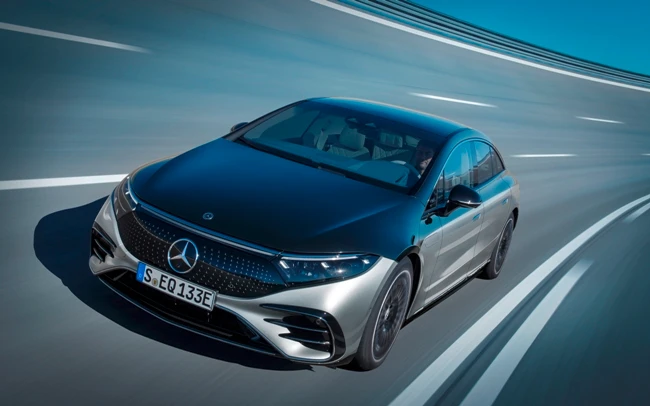
Mercedes-EQ, EQS, V 297, 2021
Mercedes says the initial models will be the EQS 450+ with 245 kW and the EQS 580 4MATIC with 385 kW. The rated power consumption rates are quoted as 20.4-15.7 kWh/100 km, and 21.8-17.4 kWh/100 km. New technology for the batteries has them enabled with a higher energy density. Of the two batteries to be available, the larger will have a usable energy content of 107.8 kWh. Mercedes says this is around 26 percent more than the EQC, their EV SUV.
It’s tech that is bespoke for M-B, with the software having been fully developed by the company and allowing over the air updates. This keeps the management system up to date, and for the life cycle of the battery. In respect to the charging rates, the DC fast charge stations pump in 200kW( and 300km in around 15 minutes. On a home charger system the EQS charges up to 22kW with AC power. The software will also allow intelligent charging programs and battery-saving charging.
A key component of EV technology is is energy recuperation. The EQS uses a program called DAuto, which can recuperate energy from deceleration to zero without the need for the brake pedal to be utilised. Smart cruise tech employs the same mechanisms with vehicle traffic ahead of the EQS. Intelligent energy recovery is situation-optimised with the aid of ECO Assist and acts with foresight, taking into account traffic conditions or topography, among other things, and up to 290kW can be generated. The driver also can set three energy recovery levels and the coast function via paddle shifters on the steering wheel.
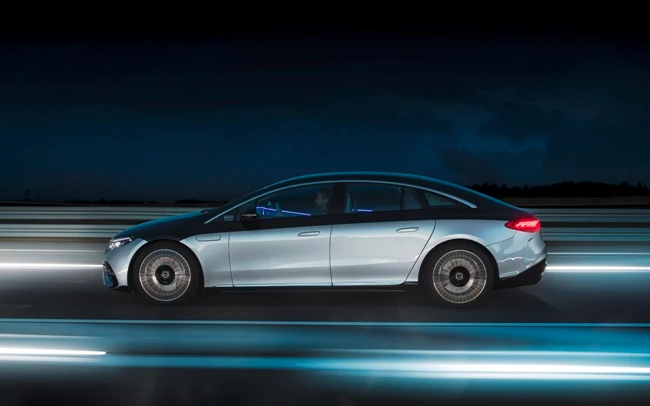
Mercedes-EQ, EQS, V 297, 2021
Also available as OTA or over the air will be the activation of vehicle functionalities. This includes two driving programs for younger aged drivers and for service staff. Light entertainment in the installation of games will also be available. Plus the updates will allow personal preference settings such as changing the steering angles for the rear wheel steering from the standard 4.5 degrees to the maximum 10 degrees. Planned is the activation of subscription services and testing on future programs.
Aerodynamics plays a big part in vehicle fuel efficiency and the new EQS has plenty of aero in the design. in fact, it’s currently rated as the most aerodynamic car available with a drag coefficient of 0.20cD. In conjunction with that slippery body is the reduction of wind noise at speed, improving comfort levels.
The need for aero is due to the EQS being on a new chassis architecture to provide a home for the powertrain. Mercedes-Benz calls the design language Sensual Purity, with smooth, organic, lines, a reduction in the join lines in panels, the fastback styling. The front end is a “Black Panel” look with the headlights running seamlessly into the grille panel which can be optioned with a 3D star pattern to complement the three-pointed Mercedes star.
Embedded throughout the EQS is a network of sensors, up to 350 of them, depending on specification. Amongst the types of information recorded are distance travelled, ambient lighting conditions, acceleration rates and speeds achieved. AI then utilises these datasets to adjust the car on the fly. This includes monitoring the battery charge levels in respect to the distance required to see the next charging point thanks to the onboard Navigation with Electric Intelligence.
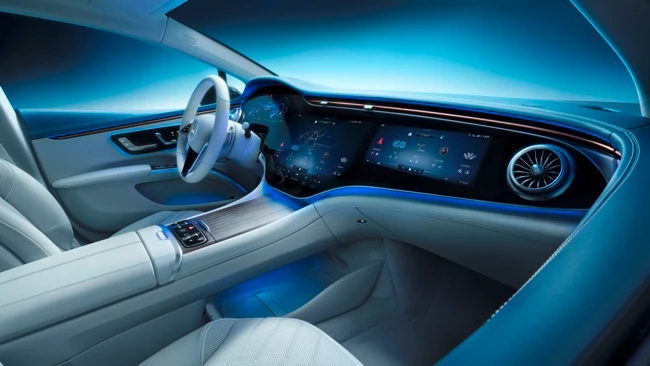
Mercedes-EQ, EQS 580 4MATIC, Interieur, Nevagrau/ Iridescentblau, AMG-Line, Edition 1; MBUX Hyperscreen; ( Stromverbrauch kombiniert: 20,0-16,9 kWh/100 km; CO2-Emissionen kombiniert: 0 g/km) // Mercedes-EQ, EQS 580 4MATIC, Interior, neva gray/ iridescent blue, AMG-Line, Edition 1; MBUX Hyperscreen ; (combined electrical consumption: 20.0-16.9 kWh/100 km; combined CO2 emissions: 0 g/km)
Being a class-setting EV, the EQS packs in some high-end green technology for the passengers. An example is the HEPA filter than can be set to fully clean the air inside the cabin before passengers enter with the onboard data system, MBUX, able to display particulate levels inside and out. Recycled materials are used in areas such as the carpets. The manufacturing process is fully carbon-offset as well.
The MBUX Hyperscreen is the absolute highlight in the interior. This large, curved screen unit sweeps almost from A-pillar to A-pillar. Three screens sit under a cover glass and appear to merge into one. The 12.3-inch OLED display for the front passenger gives him or her their own display and control area. The entertainment functions are only available there while the car is being driven in accordance with the country-specific legal regulations. Mercedes-EQ relies on an intelligent, camera-based locking logic: if the camera detects that the driver is looking at the front passenger display, it is automatically dimmed.
As part of its Ambition 2039 initiative, Mercedes-Benz is working on offering a carbon-neutral new car fleet within 20 years from now. By as early as 2030, the company wants more than half the cars it sells to feature electric drive systems – this includes fully electric vehicles and plug-in hybrids. In many areas, Mercedes is already thinking about tomorrow today: the new EQS is designed to be correspondingly sustainable. The vehicles are produced in a carbon-neutral manner, and resource-saving materials such as carpets made from recycled yarn are used. This is because Mercedes-Benz considers the entire value chain, from development and the supplier network to its own production. Mercedes-Benz AG has had its climate protection targets confirmed by the Science Based Targets Initiative (SBTI).
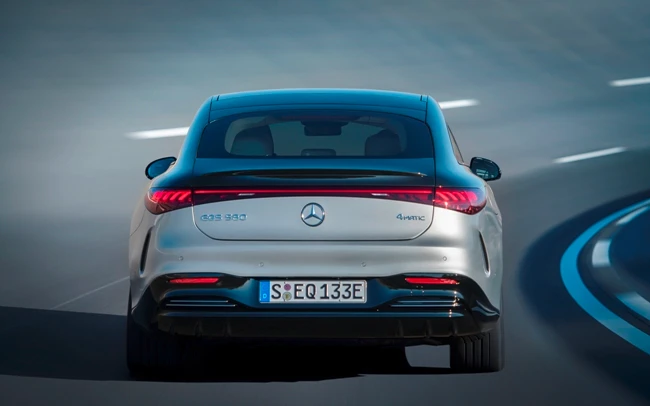
Mercedes-EQ, EQS, V 297, 2021